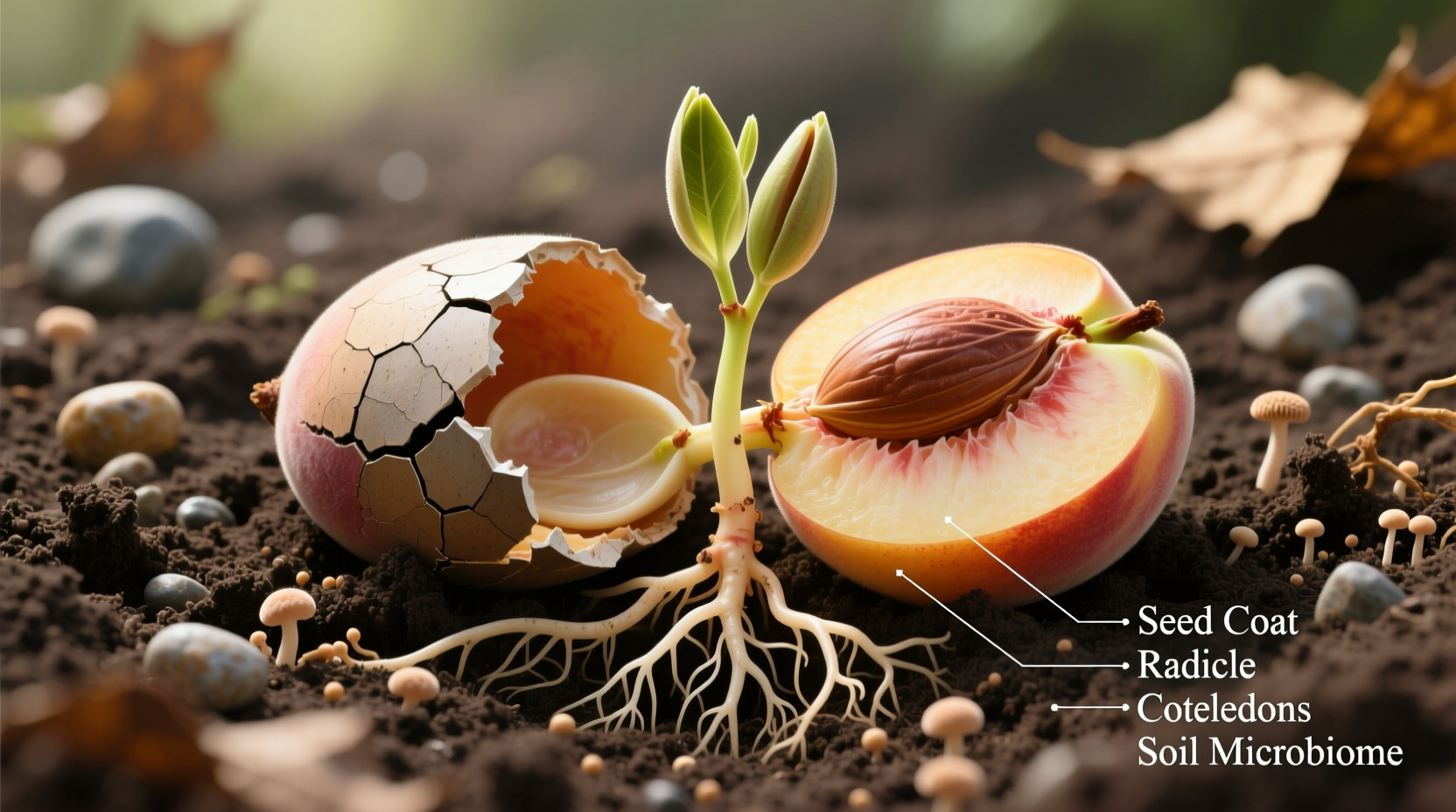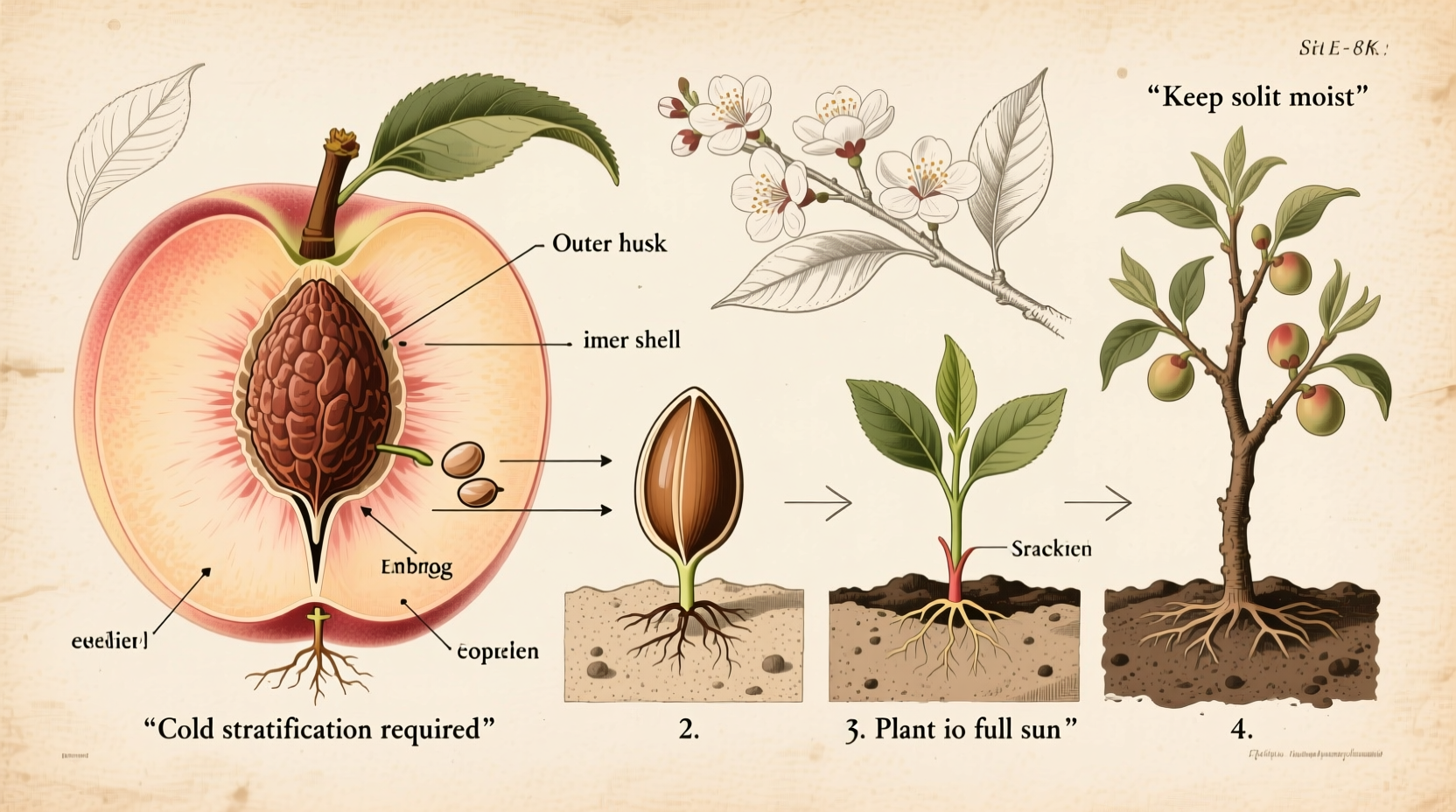Imagine harvesting your very own homegrown peaches from a tree you nurtured from a single seed. While growing peach trees from seeds requires patience and proper technique, it's a rewarding journey that connects you directly to nature's cycles. This comprehensive guide walks you through every step—from seed selection to first harvest—with science-backed methods that maximize your chances of success.
Understanding Your Peach Tree Project: Realistic Expectations
Before diving into the process, understand that growing peach trees from seeds differs significantly from purchasing grafted saplings. While seeds offer a cost-effective approach and genetic diversity, they come with specific challenges:
| Factor | Seed-Grown Trees | Grafted Trees |
|---|---|---|
| Time to Fruit | 3-4 years | 2-3 years |
| Fruit Quality | Variable (may differ from parent) | True to parent variety |
| Disease Resistance | Unpredictable | Breeder-selected rootstock |
| Success Rate | 30-40% with proper technique | 85-90% survival |
This comparison from University of Georgia Cooperative Extension shows why many commercial growers prefer grafting, but home gardeners can achieve satisfying results with seed-grown trees when following proper protocols.
Step 1: Selecting and Preparing Quality Peach Seeds
The journey begins with selecting the right seeds. Not all peach pits produce viable seedlings—choose fruits from locally grown, healthy trees that thrive in your climate zone for best adaptation.
Seed preparation process:
- Remove seeds from fully ripe peaches (never use store-bought fruit as cold storage damages viability)
- Clean thoroughly to remove all flesh residue
- Air-dry for 3-5 days away from direct sunlight
- Test viability by placing seeds in water—discard floating seeds
According to Oregon State University Extension, properly selected seeds from locally adapted trees show 20% higher germination rates than those from commercial varieties.
Step 2: Cold Stratification—Nature's Essential Trigger
Peach seeds require a period of cold, moist conditions to break dormancy—a process called stratification. Skipping this step results in near-zero germination.
Proper stratification technique:
- Wrap seeds in slightly damp paper towel or sphagnum moss
- Place in sealed plastic bag with ventilation holes
- Store in refrigerator at 33-41°F (1-5°C) for 8-12 weeks
- Check weekly for mold and maintain consistent moisture

The USDA Plants Database confirms that peach seeds need 700-1000 chilling hours below 45°F (7°C) to properly break dormancy. This mimics winter conditions necessary for natural germination.
Step 3: Planting Your Stratified Seeds
After completing cold treatment, plant your seeds when they show signs of cracking—typically late winter to early spring.
Optimal planting conditions:
- Use well-draining potting mix with pH 6.0-6.5
- Plant seeds 2-3 inches deep (pointed end down)
- Maintain soil temperature of 70-85°F (21-29°C)
- Keep soil consistently moist but not waterlogged
For best results, start seeds in 1-gallon containers to accommodate root development. Direct planting outdoors works only in USDA zones 5-9 with proper winter protection.
Step 4: Germination and Early Seedling Care
Germination typically occurs 2-8 weeks after planting, depending on temperature and seed viability. During this critical phase:
- Provide 6-8 hours of direct sunlight daily
- Maintain consistent moisture (dry soil kills young roots)
- Apply balanced fertilizer at half-strength after first true leaves appear
- Protect from late frosts with row covers
Monitor for common issues: yellowing leaves indicate nutrient deficiency, while wilting suggests improper watering. The University of Wisconsin Extension reports that seedlings receiving proper light and moisture show 65% stronger root development in the first growing season.
Step 5: Transplanting and Long-Term Tree Care
Transplant your seedling when it reaches 12-18 inches tall and after all frost danger has passed. Follow these guidelines for successful establishment:
- Choose a sunny location with at least 6 hours of direct sun
- Prepare planting hole twice as wide as root system
- Maintain original soil level—don't plant too deep
- Water deeply 2-3 times weekly during first growing season
First-year trees need regular pruning to establish strong structure. Remove competing leaders and maintain an open center shape. Apply 2-3 inches of organic mulch, keeping it away from the trunk to prevent rot.
Realistic Timeline for Seed to Harvest
Understanding the growth timeline prevents disappointment and ensures proper care:
- Weeks 1-12: Cold stratification period
- Weeks 13-16: Germination and first true leaves
- Months 4-12: Seedling establishment and first pruning
- Year 2: Vigorous growth, continued shaping
- Year 3: Possible first flowers (remove to strengthen tree)
- Year 4: First harvest (typically 1-2 peaches)
Remember that seed-grown peach trees often produce fruit different from the parent tree due to genetic variation. This isn't a failure—it's nature's surprise package! The University of Illinois Extension notes that only about 25% of seed-grown peaches match the parent fruit quality, but many develop unique, delicious characteristics.
Frequently Asked Questions
Can you grow a peach tree from a store-bought peach pit?
While possible, store-bought peach pits have significantly lower germination rates (under 10%) because commercial peaches undergo cold storage that damages seed viability. For best results, use pits from locally grown, tree-ripened peaches.
How long does it take for a peach seed to sprout?
After proper cold stratification, peach seeds typically sprout 2-8 weeks after planting in warm conditions. Germination time depends on temperature, with optimal sprouting at 70-85°F (21-29°C).
Do peach trees grown from seeds produce fruit?
Yes, but expect a 3-4 year wait before fruiting. Only about 30% of seed-grown peach trees produce quality fruit, as most exhibit genetic variation from the parent tree. The fruit may differ in size, flavor, or texture.
What climate zones work best for growing peach trees from seeds?
Peach trees thrive in USDA zones 5-9. Successful seed germination requires sufficient winter chilling hours (700-1000 hours below 45°F/7°C). Southern zones may need low-chill varieties, while northern zones require cold-hardy types.











 浙公网安备
33010002000092号
浙公网安备
33010002000092号 浙B2-20120091-4
浙B2-20120091-4